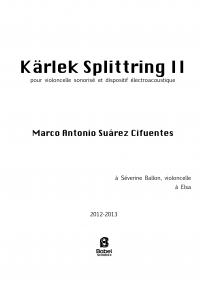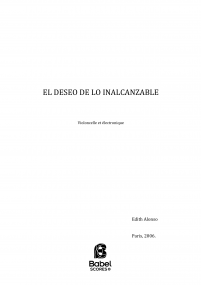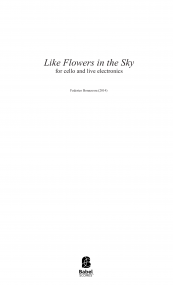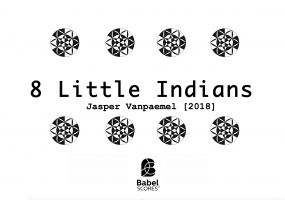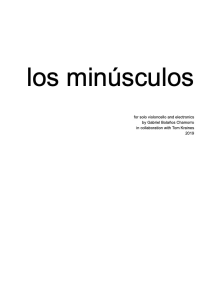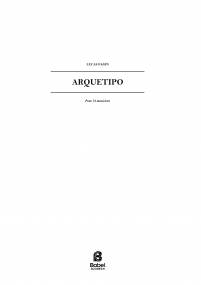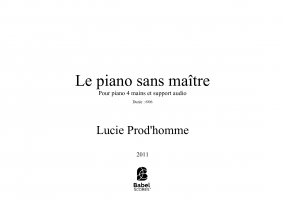Liebes-Lied
für Violoncello und Computer
15,45 €
Digital version (+0,00 €) instant download
Printed format (+14,80 € printing and shipping). Colissimo7-14 days aprox.
When you buy a score, you can contact the composer right here!
Specifications
Region
Europe
Estimated Duration
11 - 15min
Date
2002
ISMN : 979-0-2325-4001-6
Notes on this piece „Liebes-Lied für Violoncello & Computer“ is based on a poem by Rainer Maria Rilke which describes two lovers as two strings on an instrument. One
string cannot do anything without moving and being moved by the other. At the end questions such as „On which instrument are we strung?“ or:
„Which violonist holds us in his hand?“ are asked. This poem provides the global form for the piece and a certain theatrical dimension for the cellist on
stage. In the beginning, the cellist seems to be asleep. He slowly wakes up, playing his cello and evoking responses from the computer. He utters text
which is incomprehensible to the public, obviously concerned with a personal problem. After several vain attempts to get somewhere with his musical
phrases which always end with a fall, he speaks his text loudly and calms down again. From this moment on, he ceases to speak and the text only
appears via the loudspeakers, spoken by a female voice. After another outburst and a tombeau-like passage, the piece ends with an surreal „lute song“
where the cellist sings falsetto accompanying himself on the cello. This final part (with the quotation of the questions „On which instrument are we
strung?“ and „Which violonist holds us in his hand?“) suggests how the poem and the whole could possibly be interpreted.
The theatrical aspect of the live-performer, and the relationship between the cellist and the realtime live-electronics, diffused by a quadrophonic setup
of loudspeakers, is very important for the piece and cannot really be portrayed by the stereo live-recording which, by the way, overemphasizes the
front loudspeakers.
The computer part is programmed in MAX/MSP and consists of various precisely notated transformations of the cello signal (record & playback with
and without change of playback speed, ringmodulation, harmonizers, resonators, delays). There are only a few pre-recorded samples: the female voice,
a processed, bowed vibraphone note, and a pizzicato-arpeggio. All the other events are live, giving the cellist the freedom to choose the tempi he likes,
and lending the whole piece a certain fragility and virtuosity that sometimes reveals the limitations of the computer/computer player, in the same way
as the cello part at same points exceeds the possibilities of playing technique. The classical effects I use are employed to create precise musical
structures. The ringmodulation in part B, for example, has been exactly calculated in order to add to the spectral arpeggios of the cello other notes of
the spectrum. In part F several layers of delay objects, playback machines and harmonizers with envelopes are programmed to fit in rhythmically with
the live part.
The tonal material derives from a spectrum of a very low E flat (Eb –1). The cello is tuned to a scordatura that represents the partials nos 3, 5, 7 and 11
of this virtual fundamental. In order to achieve precise microintervals, the cellist plays open strings and natural harmonics, throughout almost the
whole piece.
Liebes-Lied was commissioned by the „Festival für Neue Musik Lüneburg“ for the Cellist Friedrich Gauwerky. It has been premiered in full length by Tobias Engeli, violoncello, and Sascha Lino Lemke, computer.
Add to a playlist
- Login to create your own lists
string cannot do anything without moving and being moved by the other. At the end questions such as „On which instrument are we strung?“ or:
„Which violonist holds us in his hand?“ are asked. This poem provides the global form for the piece and a certain theatrical dimension for the cellist on
stage. In the beginning, the cellist seems to be asleep. He slowly wakes up, playing his cello and evoking responses from the computer. He utters text
which is incomprehensible to the public, obviously concerned with a personal problem. After several vain attempts to get somewhere with his musical
phrases which always end with a fall, he speaks his text loudly and calms down again. From this moment on, he ceases to speak and the text only
appears via the loudspeakers, spoken by a female voice. After another outburst and a tombeau-like passage, the piece ends with an surreal „lute song“
where the cellist sings falsetto accompanying himself on the cello. This final part (with the quotation of the questions „On which instrument are we
strung?“ and „Which violonist holds us in his hand?“) suggests how the poem and the whole could possibly be interpreted.
The theatrical aspect of the live-performer, and the relationship between the cellist and the realtime live-electronics, diffused by a quadrophonic setup
of loudspeakers, is very important for the piece and cannot really be portrayed by the stereo live-recording which, by the way, overemphasizes the
front loudspeakers.
The computer part is programmed in MAX/MSP and consists of various precisely notated transformations of the cello signal (record & playback with
and without change of playback speed, ringmodulation, harmonizers, resonators, delays). There are only a few pre-recorded samples: the female voice,
a processed, bowed vibraphone note, and a pizzicato-arpeggio. All the other events are live, giving the cellist the freedom to choose the tempi he likes,
and lending the whole piece a certain fragility and virtuosity that sometimes reveals the limitations of the computer/computer player, in the same way
as the cello part at same points exceeds the possibilities of playing technique. The classical effects I use are employed to create precise musical
structures. The ringmodulation in part B, for example, has been exactly calculated in order to add to the spectral arpeggios of the cello other notes of
the spectrum. In part F several layers of delay objects, playback machines and harmonizers with envelopes are programmed to fit in rhythmically with
the live part.
The tonal material derives from a spectrum of a very low E flat (Eb –1). The cello is tuned to a scordatura that represents the partials nos 3, 5, 7 and 11
of this virtual fundamental. In order to achieve precise microintervals, the cellist plays open strings and natural harmonics, throughout almost the
whole piece.
Liebes-Lied was commissioned by the „Festival für Neue Musik Lüneburg“ for the Cellist Friedrich Gauwerky. It has been premiered in full length by Tobias Engeli, violoncello, and Sascha Lino Lemke, computer.
Instrumentation
Cello|Real-time electronics
Recording
Tobias Engeli
Score Details
Format - A4 / US Letter
Pages - 28
Pages - 28






